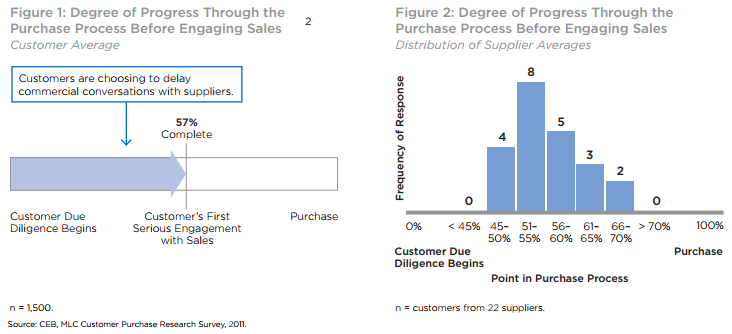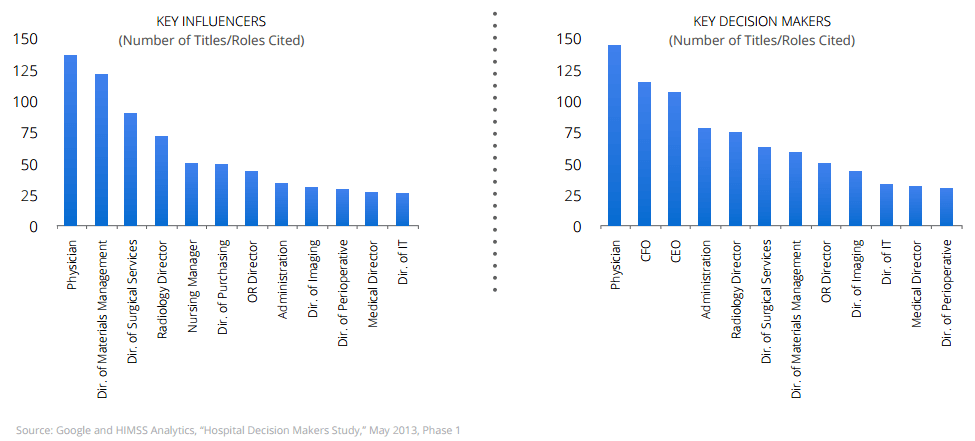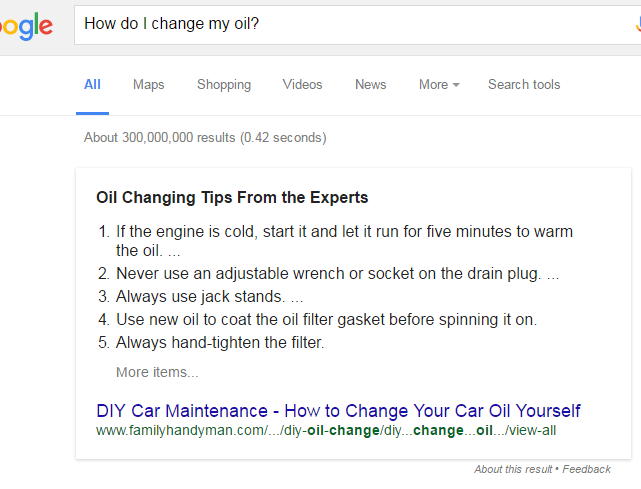Over the last five years, various studies have been released attempting to quantify just how critical is the human role of B2B sales reps. This is because online search behavior now informs prospects to such an extent it often leads to the buyer having more information about the company than the sales team has about the prospect in the first place [1].
To understand your product and learn more about how it could solve their business problem, your prospects can find informative content readily available through online forums, social networks, third-party research, unbiased reviews of the potential solution, as well as through what you publish on your own website. This is content they can consume before ever needing to contact your sales team.
To this point, CEB found that, on average, customers progress nearly 60% of the way through the purchase decision-making process before engaging a sales rep.* (See below)

*In a 2012 study The Digital Evolution in B2B Marketing by Marketing Leadership Council in partnership with Google, over 1,500 customer contacts (decision makers and influencers in a recent major business purchase) for 22 large B2B organizations were surveyed. The survey revealed that the average customer had completed more the one-half of the purchase decision-making process prior to engaging a supplier sales rep direct (Figure 1)
And while SiriusDecisions stated at their 2015 Summit that interactions with B2B sales reps occur at every stage of the buyer’s journey, they, too, had agreed two years prior that 67% of the buyer’s journey is now done digitally.
So in light of the statistics, how can a B2B company keep up with information-savvy prospects? The quick answer: blogging.
Why Company Blogging Matters
Whatever the percentage, it is clear prospects turn to online search as a means to find the answer to their business challenge. As such, search engine algorithms have advanced to make content marketing a deeply rooted component of search engine optimization.
Great content is no longer a luxury, but a need—especially for SEO. Because search engines favor rich content, a company website must have compelling content that can answer a prospect’s question. A search engine’s key objective is to produce relevant results to their users so that people will continue to use that engine. This means company websites with content beyond technical specs and datasheets have a better chance of ranking for educational, non-product-based search queries.
In addition, content on a company’s website must speak to the various audiences visiting the site. A study conducted by Google and HIMSS Analytics specific to the healthcare vertical found that over half of hospital administrators used online resources as part of the research and purchase decision making process, but that many different titles or job roles influenced the purchase decision.

Hospital Decision Makers Study conducted by Google and HIMSS Analytics
As the chart above underscores, to move a prospect successfully through the buyer journey, content must be geared toward the various influencers who will eventually inform the key decision makers.
The company blog is the recommended and ideal location on a website to publish less technical, yet educational content. It can act as point of entry for prospects beginning their search for educational information to solve their business challenge and/or need.
Whether your company already has a blog or you’re just getting started, there are a number of best practices to keep in mind to be successful in this endeavor.
Define the Audience
Buyer Personas
Before the creation of a blog begins, the author must have a clear idea of who they are writing to. Research characteristics of your target audience to create a few very specific buyer personas. Get to know these buyer personas to understand their relative level of web savviness, their role at their company, as well as the level of purchase decision authority they may have. Getting to know your buyer personas helps shape the tone and terminology to use in the blog.
Content Calendar & Keyword Focus
After the target keywords have been approved, priority is typically given to those terms the website is not yet ranking for. This happens when search engines have not yet indexed your content as related to the target keyword, so a new page must be written. Creating a content calendar means setting a priority level for these keyword targets, which then determines its date stamp for publication on the blog.
Plan to publish a blog piece one to two times each month. We recommend starting with the most important keyword the website is not currently ranking for and making that the first content calendar topic. Different teams can contribute to this; blogging is not just for the marketing department! Employ subject matter experts within the organization to develop rich blog content and have marketing apply the finishing touch to ensure consistency.
Structure Elements
Connect your blog posts to other pages on your site to tell a more complete story. Optimize blog topics to target keywords other pages are not ranking well for in the search engines, then incorporate internal links within the blog to point to deeper pages throughout your website. In this way, you can effectively move prospects through your site to great content, and hopefully further down the decision funnel.
Headline
Use the blog headline to grab a reader’s attention by targeting a key pain point or question. Focus on benefits for the reader and relate the headline to the target keyword outlined in the content calendar. Limit headlines to 70 characters and include the target keyword at the beginning if possible.
Body Copy
The blog post itself should stay closely related to the keyword target for topical consistency. The post should be about 400 to 600 words long. It is not recommended to repeat the same keyword over and over again. Rather, explaining the concept in a “human way” by using synonyms and natural language is a must.
As you may have noticed, search engines now feature “quick answers” within the search results page if the indexed content effectively answers a commonly asked question. An example of this is shown below.

Appearing as the quick answer lends credibility to the brand and the domain. This placement on the search results page can also increase organic traffic to the site because the quick answer appears at the top of the page even if your web page itself ranks lower in the results.
Formatting
Remember to include sub-headers every 150 to 200 words to break up text and increase readability. Use bulleted lists to quickly convey key points. Apply bold font formatting to distinguish important takeaways or unique selling propositions.
Images
Place at least one or two related images within the blog to break up paragraphs and improve the scannability of the page. Remember to include a short three to five word ALT tag when adding the image to the blog. ALT tags help indicate what the image is about for people using screen readers and for search engines crawling the website.
Internal Linking
Help site visitors understand the connection between the various products or solutions your company offers by including links within the body copy. These links should flow naturally within the text; limit one link per 200 words to avoid looking like a potential “spam” page to search engines.
- Product / Solution Pages: Linking to product or solution pages within the blog helps readers understand where they could navigate if interested in learning more.
- Lead Generation Pages: Most blog topics will likely be tied to a campaign and have related lead generation assets. The blog should work to explain why someone would want to learn more about the solution. It should include a call to action linking to a lead gen page (one that includes a form) so the site visitor is presented a next step and has the opportunity to download the related content offer.
- Non-Gated Assets: Not every site visitor is ready to become a lead. They may, however, be interested in related non-gated assets, such as videos or infographics. Each blog should link to at least one of these “free” assets if available.
- Series Posts: If publishing a blog as part of a series, always include links to the previous post(s). If the reader lands on “part two” of a blog that also mentions the author’s prior post, it improves the user experience to include a link to part one so the reader can easily start at the beginning of the series.
Summary
Regardless of the report you read, one thing is certain: the Internet has changed how we make our decisions. Producing easily scannable, consumable, educational content is a must for any B2B company, and a blog is the perfect platform to do so. Inbound marketing efforts can drive a prospect from consideration to decision—and yes, your sales team does still matter. Still, it doesn’t hurt to answer the common questions prospects have by dedicating resources to develop educational, informative content – empowering prospects to know they made the right choice! They are going to look online anyway, so it is to your advantage to be the one to provide helpful answers where and when your prospects are looking for them.
Need a hand with your content marketing strategy? Learn about what we offer.
